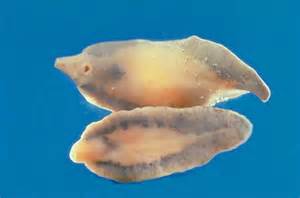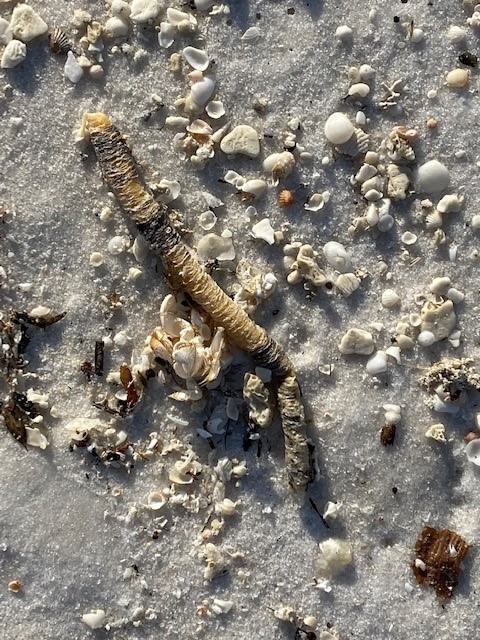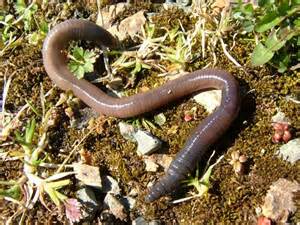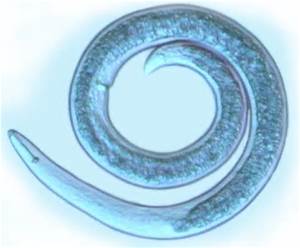As far as familiarity goes – everyone knows about worms. As far as seeing them – these are rarely, if ever seen by visitors to the northern Gulf. Most know worms as creatures that live beneath the sand – out of sight and doing what worms do. We imagine – scanning the landscape of the Gulf – millions of worms buried beneath the sediment. For some this may be quite unnerving. Worms are sometimes “gross” and associated with an unhealthy situation. You might say to your kids “don’t dig in the sand – you might get worms”. Or even “don’t drink the water – you might get worms”. But the reality of it all is that there are many kinds of worms in the northern Gulf, and many are very beneficial to the system. We will look at a few.
Flatworms are the most primitive of the group. As the name implies, they are flat. There is a head end, often with small eyespots that can detect light, but the mouth is in the middle of the body and, like the jellyfish, is the only opening for eating and going to the restroom. There are numerous species of flatworms that crawl over the ocean floor feeding on decayed detritus, many are brightly colored to advertise the fact they are poisonous – or pretending to be poisonous. And then there are species that actually swim – undulating through the water in a pattern similar to what we do with our hand when we stick it out the window driving at high speed.
But there are parasitic flatworms as well. Worms such as the tapeworm and the flukes are more well known than the free-swimming flatworms just described. These are the worms people become concerned about when they hear “there are worms out there”. And yes – they do exist in the northern Gulf. But what some people may not realize is that these internal parasites are adapted for the internal environment of their selected host and cannot survive in other creatures. There are human tapeworms and flukes, but they are not found in the sands of the Gulf.

The human liver fluke. One of the trematode flatworms that are parasitic.
Photo: University of Pennsylvania
As the name implies, roundworms are round – but they differ from earthworms in that their bodies are smooth and not segmented as earthworms are. One group of roundworms is well known in the agriculture and horticulture world – nematodes. Some nematodes are also known for being human parasites – again, creating some concern. These include the hookworm and pinworm. Roundworms can be found in the sediments by the thousands – sometimes in the millions. The abundance of some species are used as an indicator of the health of the system – the more of these particular type of roundworms, the more unhealthy the system – again, a cause of concern for some when they see any worm in the sand.
We will end with the segmented worms – the annelids. This is the group in which the familiar earthworm belongs. Though earthworms do not exist in the northern Gulf, their cousins – the polychaetae worms – are very common. Polychaetas are much larger, easier to see, and differ from earthworms in that they have extended legs from each segment called parapodia. Some polychaetas produce tubes in which they live. They will extend their antenna out to collect food. Many of these tubeworms have their tubes beneath the sand and we only see them (rarely) when their tentacles are extended – or when they extend a gelatinous mass from their tubes to collect food. But there is a type of tubeworm – the sepurlid worms – that produce small skinny calcium carbonate tubes on the sides of rocks on rock jetties, pier pilings, and even marine debris left in the water. This is also the group that the leech belongs to. Though leeches are more associated with freshwater, there are marine leeches. These are rarely encountered and do not attach to humans as their freshwater cousins do.

Diopatra are segmented worms similar to earthworms who build tubes to live in. These tubes are often found washed up on the beach.
Though we may be “creeped-out” about the presence of worms in the northern Gulf of Mexico, they are none threatening to us and are an important member of the marine community cleaning decaying creatures and waste material from the environment. We know they are there, and glad they are there.
- Our Environment: Part 17 – Energy Efficiency - August 25, 2025
- Our Environment: Part 16 – The Future of Energy - August 17, 2025
- Our Environment: Part 15 – We Need Energy - August 11, 2025


